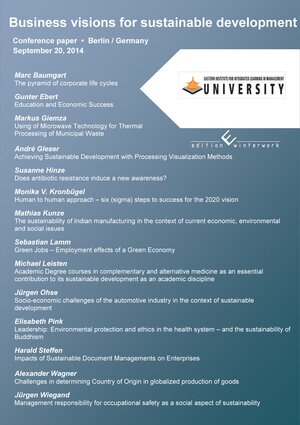
×
![Buchcover ISBN 9783864688508]()
Business visions for sustainable development
von Eastern Institute for Integrated Learning in Management UniversityLife cycle models are utilised within business administration for the purpose of describing economic relations (cf. Pümpin & Prange, 1991: 23). From the point of view of business administration, artificially created systems, for instance, companies, develop according to the same models as biological organisms (cf. Pinnekamp, 1980: 661). These models are described, in relation to the varied life cycle models, as development phases, and indicate the temporal life course of an artificially created system, from its emergence up to its demise (cf. Meffert et al., 1986: 369).
With respect to man, this course describes the period of time between birth and death, and for a company, the period from company foundation until insolvency or dissolution. In order to be able to delineate between the different development phases, characteristics such as, for instance, turnover, volume or investment requirement shall be used (cf. Meffert et al., 2012: 850p). The naming of the individual development phases (Introduction, Growth, Maturity, Decline) follows the basic principles of growth with respect to the principal characteristics applied (cf. Camphausen, 2007: 130).
Beside the corporate cycle, numerous models were developed in the last decades that focus on the diverse subjects being analysed. In relation to the products offered by a company, the product life cycle is one of the most broadly known life cycle models (cf. Levitt: 1965: 81). While ARTHUR D. LITTLE analyses in his model the life cycle of technologies (cf. Gerpott, 1999: 114), other authors take on issues that, for instance, are related to the industry branch life cycles (cf. Porter, 2008: 273p). Despite the multitude of different life cycle models, one common goal describes their use, and namely that of providing security for decisions. This means that the different life cycle models are used to estimate and evaluate future decisions (cf. Bamberger & Wrona, 2012: 339) and thus make up an important constituent component of strategic planning (cf. Hungenberg, 2012: 446).
With respect to man, this course describes the period of time between birth and death, and for a company, the period from company foundation until insolvency or dissolution. In order to be able to delineate between the different development phases, characteristics such as, for instance, turnover, volume or investment requirement shall be used (cf. Meffert et al., 2012: 850p). The naming of the individual development phases (Introduction, Growth, Maturity, Decline) follows the basic principles of growth with respect to the principal characteristics applied (cf. Camphausen, 2007: 130).
Beside the corporate cycle, numerous models were developed in the last decades that focus on the diverse subjects being analysed. In relation to the products offered by a company, the product life cycle is one of the most broadly known life cycle models (cf. Levitt: 1965: 81). While ARTHUR D. LITTLE analyses in his model the life cycle of technologies (cf. Gerpott, 1999: 114), other authors take on issues that, for instance, are related to the industry branch life cycles (cf. Porter, 2008: 273p). Despite the multitude of different life cycle models, one common goal describes their use, and namely that of providing security for decisions. This means that the different life cycle models are used to estimate and evaluate future decisions (cf. Bamberger & Wrona, 2012: 339) and thus make up an important constituent component of strategic planning (cf. Hungenberg, 2012: 446).


